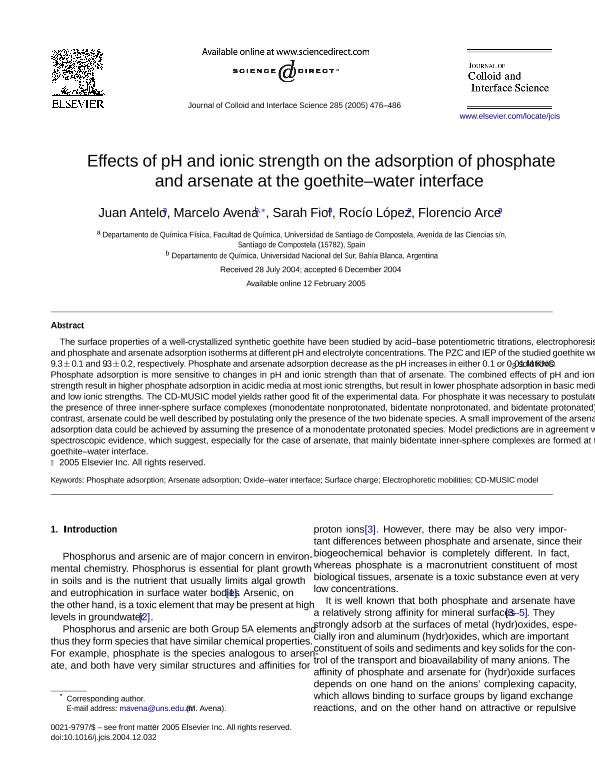Mostrar el registro sencillo del ítem
dc.contributor.author
Antelo, Juan
dc.contributor.author
Avena, Marcelo Javier

dc.contributor.author
Fiol, Sarah
dc.contributor.author
López, Rocío
dc.contributor.author
Arce, Florencio
dc.date.available
2020-01-17T22:04:29Z
dc.date.issued
2005-05
dc.identifier.citation
Antelo, Juan; Avena, Marcelo Javier; Fiol, Sarah; López, Rocío; Arce, Florencio; Effects of pH and ionic strength on the adsorption of phosphate and arsenate at the goethite-water interface; Academic Press Inc Elsevier Science; Journal of Colloid and Interface Science; 285; 2; 5-2005; 476-486
dc.identifier.issn
0021-9797
dc.identifier.uri
http://hdl.handle.net/11336/95168
dc.description.abstract
The surface properties of a well-crystallized synthetic goethite have been studied by acid-base potentiometric titrations, electrophoresis, and phosphate and arsenate adsorption isotherms at different pH and electrolyte concentrations. The PZC and IEP of the studied goethite were 9.3±0.1 and 9.3±0.2, respectively. Phosphate and arsenate adsorption decrease as the pH increases in either 0.1 or 0.01 M KNO3 solutions. Phosphate adsorption is more sensitive to changes in pH and ionic strength than that of arsenate. The combined effects of pH and ionic strength result in higher phosphate adsorption in acidic media at most ionic strengths, but result in lower phosphate adsorption in basic media and low ionic strengths. The CD-MUSIC model yields rather good fit of the experimental data. For phosphate it was necessary to postulate the presence of three inner-sphere surface complexes (monodentate nonprotonated, bidentate nonprotonated, and bidentate protonated). In contrast, arsenate could be well described by postulating only the presence of the two bidenate species. A small improvement of the arsenate adsorption data could be achieved by assuming the presence of a monodentate protonated species. Model predictions are in agreement with spectroscopic evidence, which suggest, especially for the case of arsenate, that mainly bidentate inner-sphere complexes are formed at the goethite-water interface.
dc.format
application/pdf
dc.language.iso
eng
dc.publisher
Academic Press Inc Elsevier Science

dc.rights
info:eu-repo/semantics/openAccess
dc.rights.uri
https://creativecommons.org/licenses/by-nc-sa/2.5/ar/
dc.subject
ARSENATE ADSORPTION
dc.subject
CD-MUSIC MODEL
dc.subject
ELECTROPHORETIC MOBILITIES
dc.subject
OXIDE-WATER INTERFACE
dc.subject
PHOSPHATE ADSORPTION
dc.subject
SURFACE CHARGE
dc.subject.classification
Otras Ciencias Químicas

dc.subject.classification
Ciencias Químicas

dc.subject.classification
CIENCIAS NATURALES Y EXACTAS

dc.title
Effects of pH and ionic strength on the adsorption of phosphate and arsenate at the goethite-water interface
dc.type
info:eu-repo/semantics/article
dc.type
info:ar-repo/semantics/artículo
dc.type
info:eu-repo/semantics/publishedVersion
dc.date.updated
2019-11-27T14:58:01Z
dc.journal.volume
285
dc.journal.number
2
dc.journal.pagination
476-486
dc.journal.pais
Estados Unidos

dc.description.fil
Fil: Antelo, Juan. Universidad de Santiago de Compostela; España
dc.description.fil
Fil: Avena, Marcelo Javier. Consejo Nacional de Investigaciones Científicas y Técnicas. Centro Científico Tecnológico Conicet - Bahía Blanca. Instituto de Química del Sur. Universidad Nacional del Sur. Departamento de Química. Instituto de Química del Sur; Argentina
dc.description.fil
Fil: Fiol, Sarah. Universidad de Santiago de Compostela; España
dc.description.fil
Fil: López, Rocío. Universidad de Santiago de Compostela; España
dc.description.fil
Fil: Arce, Florencio. Universidad de Santiago de Compostela; España
dc.journal.title
Journal of Colloid and Interface Science

dc.relation.alternativeid
info:eu-repo/semantics/altIdentifier/url/https://www.sciencedirect.com/science/article/pii/S0021979704012354
dc.relation.alternativeid
info:eu-repo/semantics/altIdentifier/doi/https://doi.org/10.1016/j.jcis.2004.12.032
Archivos asociados
